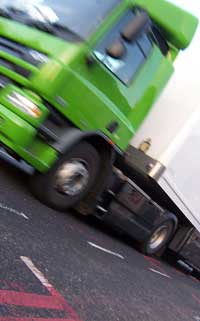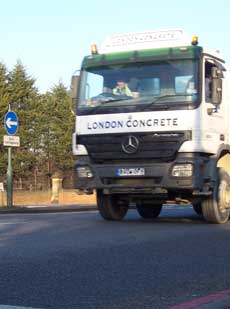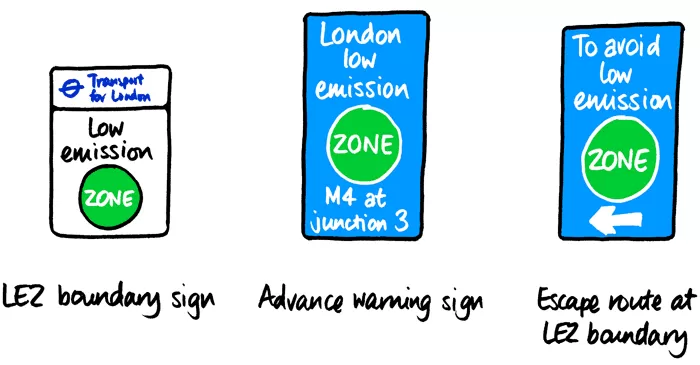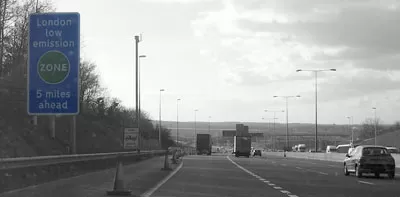Introduced in February 2008, the Low Emission Zone (LEZ) is the second road charging scheme to be introduced by Ken Livingstone as Mayor of London, following the Congestion Charge (CC) in February 2002.
While the CC was simply intended to restrict the number of private vehicles within a certain area, the LEZ claims to reduce vehicle emissions across the Greater London area, promising a measurable improvement in air quality. Its opponents claim it will damage business and that the improvement in air quality would happen without the £130m scheme.
This is not the official LEZ website
For up-to-date information, and to make enquiries about the scheme, visit Transport for London.
Details on this page were correct at November 2014.

What is it?
The Low Emission Zone (LEZ) is a scheme introduced in February 2008 to encourage the use of less polluting vehicles and penalise the heaviest polluters. It operates on almost all roads within the Greater London Authority's boundaries.
Its stated aim is to improve air quality in the city. Statistics produced by the Greater London Authority (GLA) show that, in a city that is already subject to Clean Air regulations on industrial and residential buildings, the single biggest source of air pollution (and particularly those substances that cause health problems such as asthma) is road traffic. The LEZ tackles this problem by creating a financial incentive for owners and operators of commercial vehicles to use cleaner, less polluting engines.
Those opposed to the scheme tend to see it as another measure to make road transport more difficult and to extract more money from the road haulage sector. It follows the Congestion Charge, itself a controversial scheme for similar reasons, and was introduced by Ken Livingstone, who has a long-standing reputation for pursuing policies that disadvantage private motor traffic.
Weighing heavily against the scheme is the argument that most heavy goods vehicles operating in London are already fitted with engines clean enough to be exempt from the charge, and the service life of such vehicles is sufficiently short that air quality improvements would probably happen on a similar timescale without the influence of the LEZ.
However, it seems likely that the LEZ will be revised periodically to demand higher and higher standards of engine efficiency, in order to accelerate improvements in air quality and reductions in emissions. It remains to be seen whether the LEZ will cause this ongoing change to take place at a faster rate than if it were left to market forces alone.
London isn't alone in implementing a Low Emission Zone at this time: several are already in operation across Europe and more are planned as part of a Europe-wide scheme. The website urbanaccessregulations.eu has details on each of them.
Who does it affect?
The LEZ applies to lorries, buses, coaches, many vans, motor homes, and some 4x4s and pick-up trucks. The charge applies whether the vehicle is operated by a company or an individual. It does not apply to cars or motorbikes. Historic vehicles and those mostly used off-road (such as farm machinery and some construction vehicles) are exempt.
Vehicles that meet or exceed the emissions standard are exempt from the charge, while those that do not meet it must pay. This table shows the proposed limits, correct at November 2014.
| Vehicle type | Emissions standard | Charge |
|---|---|---|
|
Euro 4 | £200 |
|
Euro 3 | £100 |
|
Euro 3 | £100 |
Transport for London assumes that vehicles are compliant with Euro 3 if they were registered after 1 October 2002 and with Euro 4 if they were registered after 1 October 2006.
The list above is not exhaustive. Transport for London have an online vehicle checker that will tell you if your vehicle is liable to pay the charge. If you are uncertain, check before taking your vehicle into the LEZ.
TfL cannot automatically check whether vehicles registered overseas are exempt from the charge. Motorists wishing to drive a foreign-registered vehicle into the LEZ should register with TfL in advance to ensure they are not charged incorrectly.
Where and when does it operate?
The LEZ covers almost all the area governed by the Greater London Authority and, unlike the Congestion Charge, is in operation at all times, including overnight and on public holidays. On each approach road to London, the zone begins at a point where there is an opportunity to avoid entering the zone. As a rough guide, virtually the whole of the Greater London urban area is within the LEZ.
The M4 east of junction 3 and the M1 south of London Gateway (Scratchwood) Services are both included in the zone, but the M11 and M25 are both completely exempt even where they enter the zone boundaries. In the case of the M11, a lack of places to U-turn mean the motorway is exempt, and a short section of the A406 North Circular Road can be used on either side of the M11's terminus to turn vehicles around without entering the LEZ.
Clear signs have been placed on all approach roads, warning of the LEZ in advance, marking the boundary, and indicating escape routes. Reminder signs are sporadically placed on main roads within the zone (shown at the top of the page).

How do I pay?
If a vehicle does not meet the standards laid out above, it must pay the daily charge to enter the LEZ. The charge applies for each day, midnight to midnight, so a vehicle that is inside the zone overnight is liable to pay the charge twice.
Automatic Number Plate Recognition (ANPR) cameras monitor major entry points and are also placed at intervals within the zone. Registration numbers are read by the cameras and checked against the DVLA database.
Because of the vast number of entry points (around 600), cameras are only placed on major roads, and therefore short trips into the edges of the zone are likely to go undetected. To combat this possibility, mobile cameras are also in operation, but the LEZ is large enough that it relies partly on trust.
The charge can be paid up to 64 days in advance, or on the day, or up to midnight on the next working day after travel. Owners of vehicles that do not meet the LEZ standard, and who have not paid the charge by midnight on the following business day, are liable to receive a penalty notice.
The charge can be paid direct to Transport for London through the LEZ website, by telephone on 0343 222 1111 (or +44 20 7310 8998 from outside the UK)*, or by post.
How do I become exempt?
If a vehicle does not comply to the relevant emissions standard, it is possible to replace or modify the engine and then have the vehicle inspected by the Vehicle and Operator Services Agency (VOSA). Once it has been certified as clean, it will become exempt.
Again, the TfL website has full details on vehicle operators' options to comply.
What happens if I don't pay?
If payment is not made by midnight on the next business day following the journey into the LEZ, TfL will issue a Penalty Charge Notice. The penalties vary depending on the size of the vehicle but can be up to £1,000. The first time a vehicle enters the zone without payment, TfL may send a warning letter instead. TfL also has the authority to clamp persistent offenders.
TfL claims to thoroughly follow up all cases involving vehicles from outside the UK. However, press reports of its record in chasing Congestion Charge fines on foreign vehicles suggest that its success rate for this may not be very high.
Vehicle owners are entitled to challenge a penalty charge notice through a formal procedure and an appeal process is available if TfL's response to a challenge is unsatisfactory.
With thanks to Mark Woolley for information on this page.


